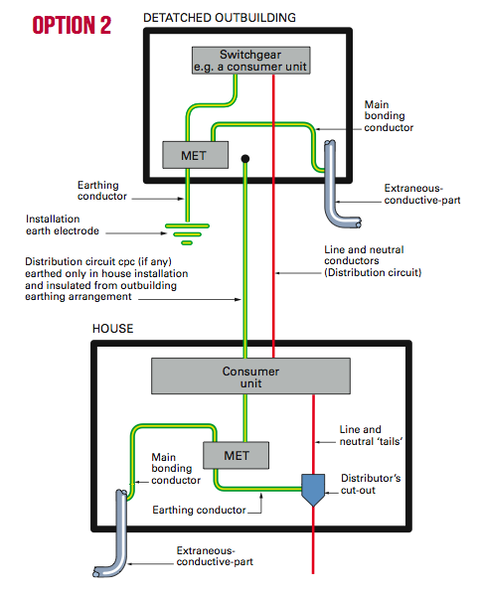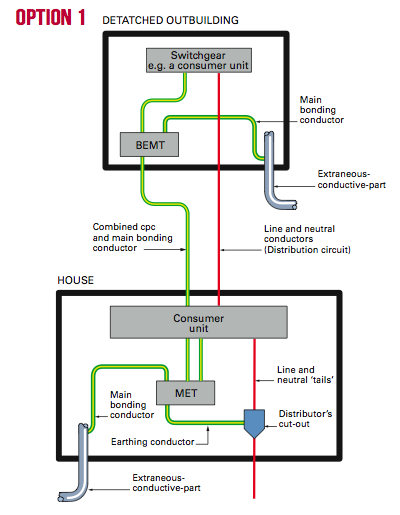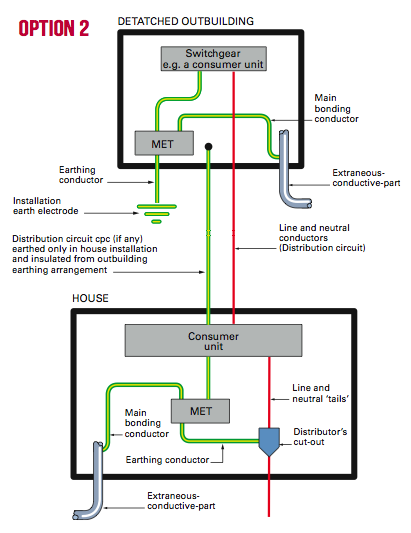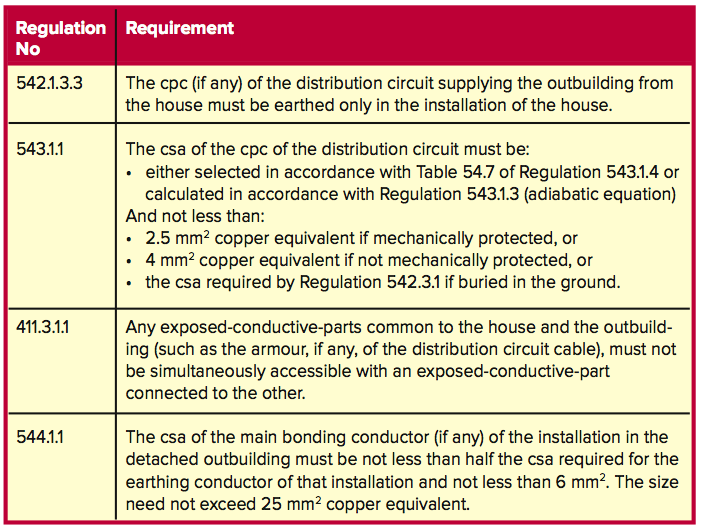Many domestic premises have one or more detached outbuildings such as a garage, garden shed or greenhouse, that require an electrical supply from the installation in the house for lighting or small power.

This article considers two options for satisfying the earthing and bonding requirements of BS 7671 for such a supply.
Basic requirements for earthing and bonding
Where an installation serves more than one building, main protective bonding is required in each building served, except for a building where there are no extraneous-conductive-parts, such as metallic water, gas or oil installation pipes (Regulation 411.3.1.2 refers).
Option 1: Extending the earthing and bonding system

The image shows an example of the earthing and bonding arrangements where the installation in a house is extended to serve a detached outbuilding. A Building Earth Marshalling Terminal (BEMT) is usually provided in the outbuilding to marshal together the main bonding conductor(s), if any, and the circuit protective conductors (cpcs) in that building. The BEMT must be connected to the MET by:
• the cpc of the distribution circuit supplying the outbuilding, and
• a main bonding conductor, if there are any extraneous-conductive-parts at the outbuilding.
As shown, the functions of the cpc and main bonding conductor (if any) may be combined in a single protective conductor having a cross sectional area (csa) meeting the requirements for both functions.
Option 2: Making the installation in the detached outbuilding part of a TT system with its own installation earth electrode and MET

The image shows an example of the earthing and bonding arrangements where an installation in a house supplies an installation in a detached outbuilding, forming part of a TT system with its own installation earth electrode and MET. It is desirable for there to be no connection between the earthing and bonding arrangement of the installation in the outbuilding and that of the installation in the house (such as through a protective conductor or shared metallic pipeline), as shown.
Note: Although both options show an earthing facility provided by the distributor being used as the means of earthing (TN-S or TN-C-S system), the earthing conductor could be connected to an installation earth electrode instead (TT system).
Table 1 – Sizing requirements for cpc and main bonding conductor

Note. The requirements of Regulation 544.1.1, referred to in Table 1, can result in a main bonding conductor size greater than that of the live conductors or cpc of the distribution circuit supplying the outbuilding, particularly where PME conditions apply (TN-C-S system).
Table 1 summarises the requirements of BS 7671 for sizing the cpc and main bonding conductor to the outbuilding. If the functions of these two conductors are combined in a single protective conductor, this must have a csa not less than that required for either function. Where there is no such connection, the main requirements of BS 7671 applying to the earthing and bonding are as summarised in Table 2.
Table 2 – Requirements where the outbuilding installation forms part of TT system with no connection to the earthing and bonding arrangements of the house installation:
 A further consideration applies where there is a connection between the earthing and bonding arrangement of the detached outbuilding and that of the installation in the house, if the latter installation forms part of a TN-C-S system where PME conditions apply.
A further consideration applies where there is a connection between the earthing and bonding arrangement of the detached outbuilding and that of the installation in the house, if the latter installation forms part of a TN-C-S system where PME conditions apply.
Where this is the case, PME diverted neutral current may flow in the connection between the two earthing and bonding systems. To avoid harmful thermal effects caused by this current, the csa of this connection and of the main bonding conductors and the earthing conductor of the installation in the outbuilding needs to meet with the requirements for a main bonding conductor of the installation in the house (which are summarised in Table 1).
- For other guidance and publications please see the NICEIC website.
- For information about the NICEIC Approved Contractor or Domestic Installers schemes,visit www.niceic.com or call 0870 013 0382
